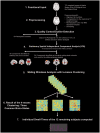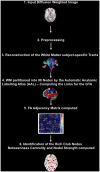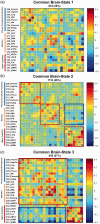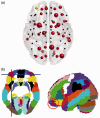Stuck in a State of Inattention? Functional Hyperconnectivity as an Indicator of Disturbed Intrinsic Brain Dynamics in Adolescents With Concussion: A Pilot Study
- PMID: 29357675
- PMCID: PMC5784460
- DOI: 10.1177/1759091417753802
Stuck in a State of Inattention? Functional Hyperconnectivity as an Indicator of Disturbed Intrinsic Brain Dynamics in Adolescents With Concussion: A Pilot Study
Abstract
Sports-related concussion in youth is a major public health issue. Evaluating the diffuse and often subtle changes in structure and function that occur in the brain, particularly in this population, remains a significant challenge. The goal of this pilot study was to evaluate the relationship between the intrinsic dynamics of the brain using resting-state functional magnetic resonance imaging (rs-fMRI) and relate these findings to structural brain correlates from diffusion tensor imaging in a group of adolescents with sports-related concussions ( n = 6) and a group of healthy adolescent athletes ( n = 6). We analyzed rs-fMRI data using a sliding windows approach and related the functional findings to structural brain correlates by applying graph theory analysis to the diffusion tensor imaging data. Within the resting-state condition, we extracted three separate brain states in both groups. Our analysis revealed that the brain dynamics in healthy adolescents was characterized by a dynamic pattern, shifting equally between three brain states; however, in adolescents with concussion, the pattern was more static with a longer time spent in one brain state. Importantly, this lack of dynamic flexibility in the concussed group was associated with increased nodal strength in the left middle frontal gyrus, suggesting reorganization in a region related to attention. This preliminary report shows that both the intrinsic brain dynamics and structural organization are altered in networks related to attention in adolescents with concussion. This first report in adolescents will be used to inform future studies in a larger cohort.
Keywords: adolescents; attention; concussion; intrinsic dynamics; multimodal magnetic resonance imaging; networks; rich club.
Figures







Similar articles
-
Alterations in resting-state brain networks in concussed adolescent athletes.J Neurotrauma. 2015 Feb 15;32(4):265-71. doi: 10.1089/neu.2013.3269. Epub 2014 Nov 25. J Neurotrauma. 2015. PMID: 25010041
-
Longitudinal Changes in Resting State Connectivity and White Matter Integrity in Adolescents With Sports-Related Concussion.J Int Neuropsychol Soc. 2018 Sep;24(8):781-792. doi: 10.1017/S1355617718000413. Epub 2018 Aug 24. J Int Neuropsychol Soc. 2018. PMID: 30139405
-
Structural and Functional Abnormalities in Children with Attention-Deficit/Hyperactivity Disorder: A Focus on Subgenual Anterior Cingulate Cortex.Brain Connect. 2017 Mar;7(2):106-114. doi: 10.1089/brain.2016.0444. Brain Connect. 2017. PMID: 28173729 Free PMC article.
-
American Medical Society for Sports Medicine position statement: concussion in sport.Br J Sports Med. 2013 Jan;47(1):15-26. doi: 10.1136/bjsports-2012-091941. Br J Sports Med. 2013. PMID: 23243113 Review.
-
Research Imaging of Brain Structure and Function After Concussion.Headache. 2018 Jun;58(6):827-835. doi: 10.1111/head.13269. Epub 2018 Feb 24. Headache. 2018. PMID: 29476532 Review.
Cited by
-
Recurrent neural network-based acute concussion classifier using raw resting state EEG data.Sci Rep. 2021 Jun 11;11(1):12353. doi: 10.1038/s41598-021-91614-4. Sci Rep. 2021. PMID: 34117309 Free PMC article.
-
Disrupted Information Flow in Resting-State in Adolescents With Sports Related Concussion.Front Hum Neurosci. 2019 Dec 12;13:419. doi: 10.3389/fnhum.2019.00419. eCollection 2019. Front Hum Neurosci. 2019. PMID: 31920584 Free PMC article.
-
Improving and standardizing concussion education and care: a Canadian experience.Concussion. 2018 Oct 24;3(4):CNC58. doi: 10.2217/cnc-2018-0007. eCollection 2018 Dec. Concussion. 2018. PMID: 30652012 Free PMC article. No abstract available.
-
Graph Analysis of the Visual Cortical Network during Naturalistic Movie Viewing Reveals Increased Integration and Decreased Segregation Following Mild TBI.Vision (Basel). 2024 May 10;8(2):33. doi: 10.3390/vision8020033. Vision (Basel). 2024. PMID: 38804354 Free PMC article.
-
Adaptive frequency-based modeling of whole-brain oscillations: Predicting regional vulnerability and hazardousness rates.Netw Neurosci. 2019 Sep 1;3(4):1094-1120. doi: 10.1162/netn_a_00104. eCollection 2019. Netw Neurosci. 2019. PMID: 31637340 Free PMC article.
References
-
- Anderson V., Spencer-Smith M., Leventer R., Coleman L., Anderson P., Williams J., Greenham M., Jacobs R. (2009) Childhood brain insult: Can age at insult help us predict outcome? Brain A J Neurol 132: 45–56. - PubMed
-
- Ashburner J. (2007) A fast diffeomorphic image registration algorithm. Neuroimage 38: 95–113. - PubMed
-
- Barker-Collo S., Jones K., Theadom A., Sarkey N., Dowell A., McPherson K., Ameratunga S., Dudley M., Te Ao B., Feigin V. (2015) Neuropsychological outcome and its correlates in the first year after adult mild traumatic brain injury: A population-based New Zealand study. Brain Inj 29(13–14): 1604–1616. - PubMed
-
- Barlow K. M., Crawford S., Stevenson A., Sandhu S. S., Belanger F., Dewey D. (2010) Epidemiology of postconcussion syndrome in pediatric mild traumatic brain injury. Pediatrics 126: e374–e381. - PubMed
Publication types
MeSH terms
Substances
LinkOut - more resources
Full Text Sources
Other Literature Sources
Medical
